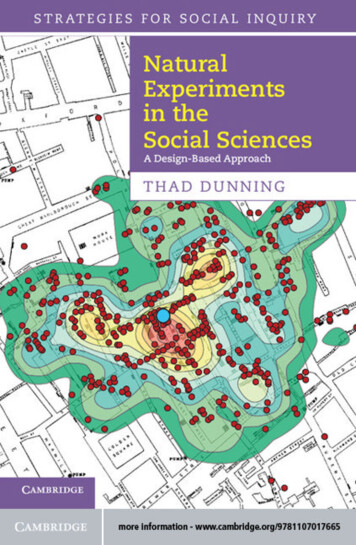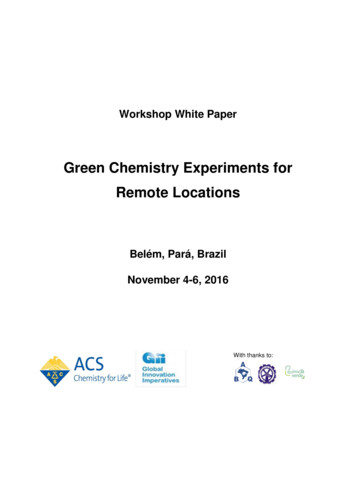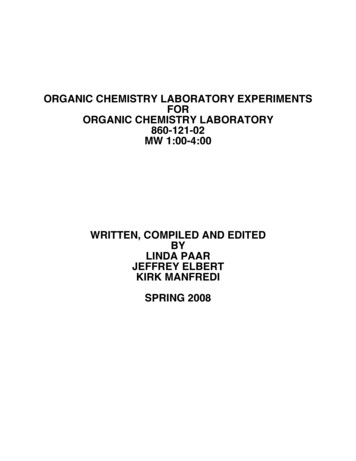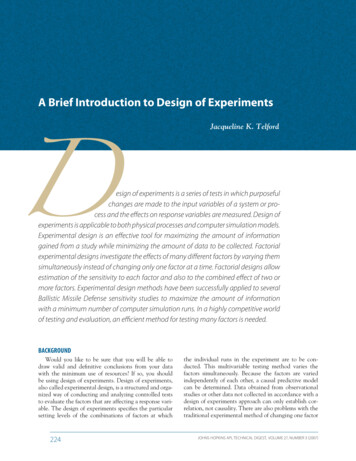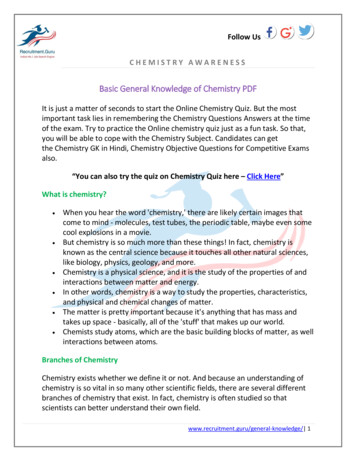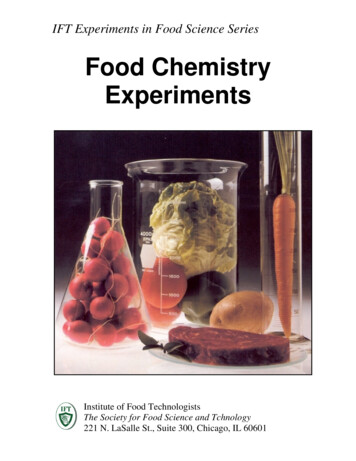
Transcription
IFT Experiments in Food Science SeriesFood ChemistryExperimentsInstitute of Food TechnologistsThe Society for Food Science and Tchnology221 N. LaSalle St., Suite 300, Chicago, IL 60601
FOOD CHEMISTRY EXPERIMENT BOOKThese experiments have multiple instructional applications and can be incorporated intocurrently used materials and activities. Some suggested uses are: Hands-on experiments in the classroom. Demonstrations. Ideas for science projects. Take-home assignments. Hands-on experiments in home schooling.Table of ContentsTEACHER INTRODUCTION. 3STUDENT INTRODUCTION . 5Figure 1. 6Unit 1. CARBOHYDRATES .1-1Teacher Activity Guide .1-1Student Activity Guide .1-5Figure 1.1-6Activity/Experiment .1-9Cryptic Carbohydrates.1-11Cool Carbs.1-13Unit 2. LIPIDS.2-1Teacher Activity Guide .2-1Student Activity Guide .2-6Figure 1.2-7Activity/Experiment .2-10Freaky Fats .2-14Phats .2-16Unit 3. PROTEINS .3-1Teacher Activity Guide .3-1Student Activity Guide .3-9Figure 1.3-10Activity/Experiment .3-14Powerful Proteins .3-19Puzzling Proteins.3-21APPENDICES .4-1Pictures Illustrating Experimental Outcomes .4-1MOLECULAR MATCHING .4-2Institute of Food Technologists, IFT Experiments in Food Science SeriesCopyright Purdue Research Foundation. All rights reserved. 20001
Institute of Food Technologists Experiments in Food Science SeriesThe Institute of Food Technologists (IFT) is a scientific professional society witha membership of more than 28,000. The purpose of the Institute is to supportimprovement of the food supply and its use through science, technology, and education.Individual objectives of the Institute are to promote programs, implement proposals, andprovide guidance consistent with and in support of the Institute.The IFT Experiments in Food Science Series has been developed as a specialproject of the Career Guidance Committee of the Institute of Food Technologists, ascientific educational society with an interest in global concerns for providing a safe andwholesome food supply. This curriculum guide was developed for science teachers forgrades 8 through 12 to enhance the learning in existing science-oriented courses. Thefollowing instructional materials contain educational hands-on activities to help studentsunderstand specific scientific facts and principles as they relate to the science of food.For more information on the IFT Experiments in Food Science Series, contact theProfessional Development Department, Institute of Food Technologists, 221 N. LaSalleStreet, Suite 300, Chicago, IL 60601. Phone 312/782-8424, Fax 312/782-0045, Internetaddress www.ift.org/careers/index.shtml.PRINCIPAL AUTHORSBruce A. Watkins, Ph.D., Professor and University Faculty Scholar, Department ofFood Science, School of Agriculture, Purdue University, West Lafayette, Indiana and theBiological and Agricultural Science Education (B.A.S.E.) Consortium. Specialassistance from B.A.S.E. (www.ag.purdue.edu/base) including Cynthia T. Watkins,B.S., Consultant for High School Science, Laura Rogers, M.S., Research Administrator,Kellen Maicher, B.S., Computer Graphics, and Yong Li, Ph.D., Research Associate.Contributions and suggestions from Beverly Friend, Ph.D., Friend Consulting Services,Inc. and the members of the IFT Career Guidance Committee is acknowledged. Editedby Neil H. Mermelstein, Senior Editor, Food Technology, Institute of FoodTechnologists.Institute of Food Technologists, IFT Experiments in Food Science SeriesCopyright Purdue Research Foundation. All rights reserved. 20002
TEACHER INTRODUCTIONFood chemistry is a major part of a larger discipline of study known as foodscience. Food science is an interdisciplinary study involving microbiology, biology,chemistry, engineering, and biotechnology. Food science is the application of scienceand engineering to the production, processing, distribution, preparation, evaluation, andutilization of food. Food chemistry encompasses the composition and properties of foodcomponents and the chemical changes they undergo during handling, processing, andstorage. A food chemist must know chemistry and biochemistry and have knowledge ofphysiological chemistry, botany, zoology, and molecular biology to study and modifybiological substances as sources of human food. Food chemists work with biologicalsystems that are dead or dying (post-harvested plants and postmortem animal tissues) andstudy the changes they undergo when exposed to different environmental conditions. Forexample, during the marketing of fresh tomatoes, the food chemist must determine theoptimal conditions to sustain the residual life in the tomatoes so the tomatoes willcontinue to ripen and arrive at the supermarket as a high-quality product for theconsumer. Vital to understanding food science is the knowledge of the primarycompounds in food. These compounds are carbohydrates, lipids, and proteins. Theexperiments and background information focus on the chemistry (functional properties)and structure of these compounds found in foods.Food science also includes biotechnology, which is the use of biological processesto make new foods, enzymes, supplements, drugs, and vaccines. For thousands of years,people have been using microorganisms in the fermentation of beer and in the making ofcheeses, wines, and breads. Today biotechnology also encompasses geneticallyengineered foods. In genetic engineering, scientists splice genetic material from plants,animals, or bacteria and insert this genetic material into the DNA of other organisms.These new organisms are called genetically modified organisms (GMOs).Before we can discuss food chemistry, the students must understand basicchemistry concepts. The student introduction explains food chemistry. The introductionalso includes general background information on chemical bonds.VocabularyThe atom is the smallest possible unit of an element, consisting of protons, neutrons, andelectrons. The atom is the tiniest part of a chemical element that has all the properties ofthat element. The smallest speck that can be seen under an ordinary microscope containsmore than 10 billion atoms.Institute of Food Technologists, IFT Experiments in Food Science SeriesCopyright Purdue Research Foundation. All rights reserved. 20003
A chemical bond is an attractive electrical force between atoms strong enough to permitthem to function as a unit, called a molecule. Both positive ( ) and negative (–) electricalcharges attract, just as magnetic north and south poles attract.The molecule is the smallest physical unit of an element or compound, consisting of oneor more like atoms in an element and two or more different atoms in a compound.This module, Food Chemistry, contains three major units: Carbohydrates,Lipids, and Proteins. Each unit includes a Teacher Activity Guide and a StudentActivity Guide. Teacher Activity Guides present the teacher with all backgroundinformation he or she will need to perform the experiments, as well as questions andanswers and sample data tables. Student Activity Guides contain backgroundinformation relevant to the unit, procedures, and key questions and data tables for thestudents to complete. Teachers may photocopy this section for distribution to thestudents.The experiments in each unit are intended as demonstrations only. The fooditems and products produced should not be consumed.There is a supplemental CD-ROM called "The Pizza Explorer" that the studentcan use as an independent study exercise on food chemistry. The Pizza Explorer is aninteractive program that allows for further learning about food science at a student’s ownpace.Molecular models provide a tangible, visual means of introducing therelationships between chemical structure and functional behavior of food molecules. Thepictures of chemical structures illustrated in this experiment book were made with amolecular model kit. This kit is available from Molecular Modeling Kits (Molymod) bySpiring Enterprises, Ltd. For further information contact Philip Spiring, Beke Hall,Billingshurst, West Sussex, England RH14 9HF, Telephone 01403 782387, E-mailmolymod@globalnet.co.uk, Web site www.molymod.com. The kit contains the four basicatoms found in foods: carbon, oxygen, hydrogen, and nitrogen. The kit can be used tobuild sugars (glucose and fructose), fatty acids and triacylglycerols, and amino acids.The models can also demonstrate stereochemical principles, such as cis and trans doublebond configurations in fatty acids, alpha and beta glycosidic linkages in sugars, and the Land D configurations of amino acids.Institute of Food Technologists, IFT Experiments in Food Science SeriesCopyright Purdue Research Foundation. All rights reserved. 20004
STUDENT INTRODUCTIONFood chemistry is a major part of a larger area of study known as food science.Food science is an interdisciplinary study involving microbiology, biology, chemistry,and engineering. Food science is the production, processing, distribution, preparation,evaluation, and utilization of food. Food chemistry encompasses the composition andproperties of food components and the chemical changes they undergo during handling,processing, and storage. A food chemist must know chemistry and biochemistry andhave knowledge of physiological chemistry, botany, zoology, and molecular biology tostudy and modify biological substances as sources of human food. Food chemists workwith biological systems that are dead or dying (post-harvested plants and postmortemanimal tissues) and study the changes they undergo when exposed to differentenvironmental conditions. For example, during the marketing of fresh tomatoes, the foodchemist must determine the optimal conditions to sustain the residual life in the fruit sothey will continue to ripen and arrive at the supermarket as a high-quality product for theconsumer. Vital to understanding food science is the knowledge of the primarycomponents or compounds in food. These compounds are carbohydrates, lipids, andproteins. A major focus of this experiment book is to learn the chemistry and structure ofthese compounds in foods.Food science also includes biotechnology, which is the use of biological processesto make new foods, enzymes, supplements, drugs, and vaccines. For thousands of years,people have been using microorganisms in the fermentation of beer, and in the making ofcheeses, wines, and breads. Today biotechnology also encompasses geneticallyengineered foods. In genetic engineering, scientists splice genetic material from plants,animals, or bacteria and insert this genetic material into the DNA of other organisms.These new organisms are called genetically modified organisms (GMOs).The experiments in each unit are intended as demonstrations only. The fooditems and products produced should not be consumed.GENERAL BACKGROUND ON CHEMICAL BONDSHow are food molecules held together? The atoms are connected by chemicalbonds. The chemical bond forms the chemical structure of the molecules and affects thefunctional behavior of the molecules. This is the reason why carbohydrates and fats,which are made of the same elements, have different physical and chemical properties. Achemical bond formed by the sharing of one or more electrons, especially pairs ofelectrons, between atoms is called a covalent bond. There are different types of bondsthat hold the atoms of molecules together, but we will restrict our discussion to covalentbonds. The following structures are examples of covalent bonds. Carbon is the blackatom, hydrogen is white, oxygen is red, and nitrogen is blue.Institute of Food Technologists, IFT Experiments in Food Science SeriesCopyright Purdue Research Foundation. All rights reserved. 20005
A.B.C.D.Figure 1A. A single covalent bond between two carbon atoms. There is only one pair ofshared electrons between two adjacent atoms. The two atoms are free to rotate360o.B. A double covalent bond between two carbon atoms. There are two pairs ofshared electrons between two adjacent atoms. This bond brings the atoms closertogether and is stronger than a single bond. There is no free rotation between thetwo atoms.C. A cis double bond is where the hydrogen atoms are on the same side of thedouble bond. The word “cis” means located near or on the same side.D. A trans double bond is where the hydrogen atoms are on the opposite sides ofthe double bond. The word “trans” means located across or away from.Institute of Food Technologists, IFT Experiments in Food Science SeriesCopyright Purdue Research Foundation. All rights reserved. 20006
Unit 1. CARBOHYDRATESTeacher Activity GuideExpected OutcomeThe student will learn about the sources of carbohydrates and their uses in the foodindustry. The students will be able to use a carbohydrate to modify another foodsubstance and explain how food chemistry was involved.Activity ObjectiveStudents will use pectin in conjunction with an acid and sugar to form jelly. By varyingthe sugar concentrations, the students will observe that there is an optimum ratio for thecreation of this spreadable gel.Activity LengthPart 1 - 20 minutesPart 2 - 20 minutesPart 3 - 20 minutesScientific PrinciplesPectin solutions form gels when an acid and sugar are added. As the pH is decreased bythe addition of acid, the carbohydrate chains of the pectin molecule join together to forma polymer network, which entraps the aqueous solution. The formation of these junctionzones is aided by high concentrations of sugar, which allow the chains to interact withone another by dehydrating (pulling water away from) the pectin molecules. Thisincreases the strength and rigidity of the gel.VocabularyAmylase is an enzyme that hydrolyzes starch polymers to yield glucose and maltose.Salivary amylase begins the chemical breakdown of large starch molecules into smallersugar molecules.Carbohydrate is a compound of carbon and water with the basic formula CnH2On. [Note:condensation products, such as sucrose, have one less H2O and a formula CnH2O(n-1)].Carbohydrates are the most abundant of all carbon-containing compounds, composingnearly three-fourths of the dry mass of all plant life on earth. Examples of carbohydratesinclude glucose, sucrose (table sugar), starch, and cellulose.Institute of Food Technologists, IFT Experiments in Food Science SeriesCopyright Purdue Research Foundation. All rights reserved. 20001-1
Cellulose is a polymer of glucose, linked by beta-1,4-glycosidic bonds. It is a complexcarbohydrate similar in structure to starch. Examples are cotton, wood, and paper. Aspart of the human diet, cellulose helps prevent constipation and fights colon cancer.Fructose is a sugar occurring naturally in a large number of fruits and honey. It is thesweetest of all common sugars. It is a simple carbohydrate with the formula C6H12O6.Galactose is a simple sugar having the same chemical formula (C6H12O6) as glucose andfructose, but a different arrangement of its atoms. It is an isomer of glucose with ahydroxyl group on carbon 4 reversed in position. Galactose is often found incarbohydrates used in cellular recognition, such as blood types and neural receptors.Glucose is a simple sugar (C6H12O6) and the primary source of energy for all mammalsand many plants. It is also known as dextrose, grape sugar, and corn sugar. It is abouthalf as sweet as table sugar.Hydrolysis is a chemical process whereby a compound is cleaved into two or moresimpler compounds with the uptake of the H and OH parts of a water molecule on eitherside of the chemical bond that is cleaved. During digestion, the intestinal enzyme sucrasehydrolyzes (adds water to) sucrose (C12H22O11) to produce glucose (C6H12O6) fructose(C6H12O6) in the intestinal tract.Hemiacetal is a product of the addition of an alcohol to an aldehyde. An aldehyde is acompound containing the radical CH O, reducible to an alcohol (CH2OH) and oxidizableto a carboxylic acid (COOH).Isomers are two or more molecules with the same number and kind of atoms, butdifferent arrangements of those atoms.Lactase is an enzyme that hydrolyzes lactose into glucose and galactose, which can beabsorbed into the bloodstream.Lactose is a disaccharide composed of galactose and glucose linked by a beta-1,4glycosidic bond. Lactose is found in cow’s milk and other dairy products.Maltose is a disaccharide composed of two molecules of glucose linked by an alpha-1,4glycosidic bond. It is obtained from the hydrolysis of starch, and is used to flavor somecandy. Maltose must be hydrolyzed to glucose before it can be absorbed and taken intothe bloodstream.Polymers contain two or more monomers. Starch is a polymer of the monomer glucose.Protein is a polymer of amino acids.Institute of Food Technologists, IFT Experiments in Food Science SeriesCopyright Purdue Research Foundation. All rights reserved. 20001-2
Starch is a polymer of glucose, linked by alpha-1,4-glycosidic bonds. Starch is acomplex carbohydrate found in green plants, and an important source of energy foranimals and humans. During the day, green plants store energy by converting glucose tostarch. At night, plants convert starch back to glucose for growth.Stereochemistry is the branch of chemistry concerned with the spatial three-dimensionalrelations of atoms in molecules. For example, stereochemistry refers to the relativepositions of atoms or groups of atoms in the molecule or compound and the effect ofthese positions on its properties.Sucrose (C12H22O11) is a disaccharide made up of glucose and fructose. Sucrose isobtained from cane sugar, sorghum, and sugar beets. Sucrose is the name for commontable sugar, which can’t be used by the body unless it is broken down by the enzymesucrase into monosaccharides by the process of digestion. Absorption of glucose andfructose occurs in the small intestine.Materials RequiredSure-Jell Concentrated fruit juice (apple, grape), thawed, if frozenGranulated sugarWater600-milliliter beakersBunsen burner w/ stands or hot plateHeatproof glovesBalance or scaleGraduated cylinderHeatproof padStirring rod/spoon/wooden PopsiclestickInstructional Strategies and ProceduresYou will be able to complete and observe the entire experiment in one class period, if youdivide the class into three groups and each group does one part of the experiment.Teaching Tips The foods produced in these experiments are not to be consumed.Purchase the regular Sure-Jell. It contains pectin, acid and dextrose (glucose).You can use either frozen juice concentrate or the nonrefrigerated, asepticallyprocessed juice concentrates found in the fruit juice section of the supermarket.Caution the students against overheating the jelly. Once the jelly starts to boil, it willbubble up and over the top of the beaker.Institute of Food Technologists, IFT Experiments in Food Science SeriesCopyright Purdue Research Foundation. All rights reserved. 20001-3
EXPERIMENTPart 1Part 2Part 3SAMPLE DATA TABLE - JELLY CONSISTENCYJELLYCONSISTENCY *NormalFirmHalf sugarRunny; viscosity is like glueTwice sugarHas some firmness, will not hold a shape*Jelly results based on the use of Mott’s In-A-Minute Unfrozen Grape Concentrate.Key Questions and Answers1. How did the consistency of the jelly change when you changed the ratio of sugar topectin?When you used half the normal amount of sugar, the jelly was runny; when you usedtwice the sugar, the jelly was soft and did not hold its shape.2. Why did the consistency change when you changed the ratio of sugar to pectin?There is an optimum ratio for jelly formation. The addition of sugar increases thefirmness of the gel by aiding in the formation of polymer junctions. The addition oftoo much sugar, however, interferes with the gelling process. Although themechanism for this reaction is not known, it is thought that very high concentrationsof sugar dehydrate the pectin molecules to such an extent that some of the entrappedwater is pulled out of the gel and back into solution. The result would be a softer gelthat would not hold its shape.Web sites for more information on my/cornpage.html - Iowa State University.Contains general, technical, and production information on corn.http://205.156.215.10/ - A. E. Staley Manufacturing Company. Information on food andindustrial starches, sweeteners, and corn wet milling rch/index.htm - Oregon State University.Information on starch, its uses and composition.Institute of Food Technologists, IFT Experiments in Food Science SeriesCopyright Purdue Research Foundation. All rights reserved. 20001-4
Student Activity GuideCARBOHYDRATESCarbohydrates make up a group of chemical compounds found in plant andanimal cells. They have the empirical formula CnH2nOn, or (CH2O)n. An empiricalformula tells the atomic composition of the compound, but nothing about structure, size,or what chemical bonds are present. Since this formula is essentially a combination ofcarbon and water, these materials are called “hydrates of carbon”, or carbohydrates forshort.Carbohydrates are the primary products of plant photosynthesis. The simplifiedlight-driven reaction of photosynthesis results in the formation of a carbohydrate: nH2O nCO2 -(CH2O)n- nO2. This type of carbohydrate is found in the structures ofplants and is used in the reverse reaction of photosynthesis (respiration) or is consumedas fuel by plants and animals.Carbohydrates are widely available and inexpensive, and are used as an energysource for our bodies and for cell structures. Food carbohydrates include the simplecarbohydrates (sugars) and complex carbohydrates (starches and fiber). Before a bigrace, distance runners and cyclists eat foods containing complex carbohydrates (pasta,pizza, rice and bread) to give them sustained energy.Carbohydrates are divided into monosaccharides, disaccharides, andpolysaccharides. As shown in the following molecular model structures, carbohydratesmay be found as hexagon (6-sided, see Figure 1A) and pentagon (5-sided, see Figure1B) shaped rings.MonosaccharidesMonosaccharides are single-molecule sugars (the prefix “mono” means one) thatform the basic units of carbohydrates. They usually consist of three to seven carbonatoms with attached hydroxyl (OH) groups in specific stereochemical configurations. Thecarbons of carbohydrates are traditionally numbered starting with the carbon of thecarbonyl end of the chain (the carbonyl group is the carbon double-bonded to oxygen).The number of carbons in the molecule generally categorizes monosaccharides. Forexample, three-carbon carbohydrate molecules are called trioses, five-carbon moleculesare called pentoses, and six-carbon molecules are called hexoses.Institute of Food Technologists, IFT Experiments in Food Science SeriesCopyright Purdue Research Foundation. All rights reserved. 20001-5
Ribose and 2-deoxyribose are pentoses, and both have a crucial role inreproduction as polymers known as ribonucleic acid (RNA) and deoxyribonucleic acid(DNA). One of the most important monosaccharides is glucose (dextrose). Thismolecule is the primary source of chemical energy for living systems. Plants and animalsalike use this molecule for energy to carry out cellular processes. Mammals producepeptide hormones (insulin and glucagon) that regulate blood glucose levels, and a diseaseof high blood glucose is called diabetes. Other hexoses include fructose (found in fruitjuices) and galactose.Different structures are possible for the same monosaccharide. Although glucoseand fructose are identical in chemical composition (C6H12O6), they are very different instructure (see molecular models). Such materials are called isomers. Isomers in generalhave very different physical properties based on their structure.A.B.C.D.Figure 1A. Glucose, a six-membered ring monosaccharide. B. Fructose, a five-memberedring monosaccharide. C. Sucrose, a disaccharide containing glucose and fructose.D. Molecular representation of starch illustrating the alpha-glycosidic linkagesjoining monosaccharides to form the polysaccharide structure.Institute of Food Technologists, IFT Experiments in Food Science SeriesCopyright Purdue Research Foundation. All rights reserved. 20001-6
DisaccharidesDisaccharides are two monosaccharide sugar molecules that are chemicallyjoined by a glycosidic linkage (- O -) to form a “double sugar” (the prefix “di” meanstwo). When two monosaccharide molecules react to form a glycosidic bond (linkage), awater molecule is generated in the process through a chemical reaction known ascondensation. Therefore, condensation is a reaction where water is removed and apolymer is formed. The most well known disaccharide found in nature is sucrose, whichis also called cane sugar, beet sugar, or table sugar (see Figure 1C). Sucrose is adisaccharide of glucose and fructose. Lactose or milk sugar is a disaccharide of glucoseand galactose and is found in milk. Maltose is a disaccharide composed of two glucoseunits. Disaccharides can easily be hydrolyzed (the reverse of condensation) to becomemonosaccharides, especially in the presence of enzymes (such as the digestive enzymesin our intestines) or alkaline catalysts. Invert sugar is created from the hydrolysis ofsucrose into glucose and fructose. Bees use enzymes to create invert sugar to makehoney. Taffy and other invert sugar type candies are made from sucrose using heat andalkaline baking soda.Disaccharides are classified as oligosaccharides (the prefix “oligo” means few orlittle). This group includes carbohydrates with 2 to 20 saccharide units joined together.Carbohydrates containing more than 20 units are classified as polysaccharides.PolysaccharidesPolysaccharides (the prefix “poly” means many) are formed when many singlesugars are joined together chemically. Carbohydrates were one of the original moleculesthat led to the discovery of what we call polymers. Polysaccharides include starch,glycogen (storage starch in animals), cellulose (found in the cell walls of plants), andDNA.Starch is the predominant storage molecule in plants and provides the majority ofthe food calories consumed by people worldwide. Most starch granules are composed ofa mixture of two polymers: a linear polysaccharide called amylose and a branched-chainpolysaccharide called amylopectin. Amylopectin chains branch approximately every 2025 saccharide units. Amylopectin is the more common form of starch found in plants.Animals store energy in the muscles and liver as glycogen. This molecule is more highlybranched than amylopectin. For longer-term storage, animals convert the food caloriesfrom carbohydrates to fat. In the human and animals, fats are stored in specific parts ofthe body called adipose tissue.Cellulose is the main structural component of plant cell walls and is the mostabundant carbohydrate on earth. Cellulose serves as a source of dietary fiber since, asexplained below, humans do not have the intestinal enzymes necessary to digest it.Institute of Food Technologists, IFT Experiments in Food Science SeriesCopyright Purdue Research Foundation. All rights reserved.
Jun 16, 2017 · Food chemistry is a major part of a larger area of study known as food science. Food science is an interdisciplinary study involving microbiology, biology, chemistry, and engineering. Food science is the production, processing, distribution, preparation, evaluation, and utilization of food. Food

